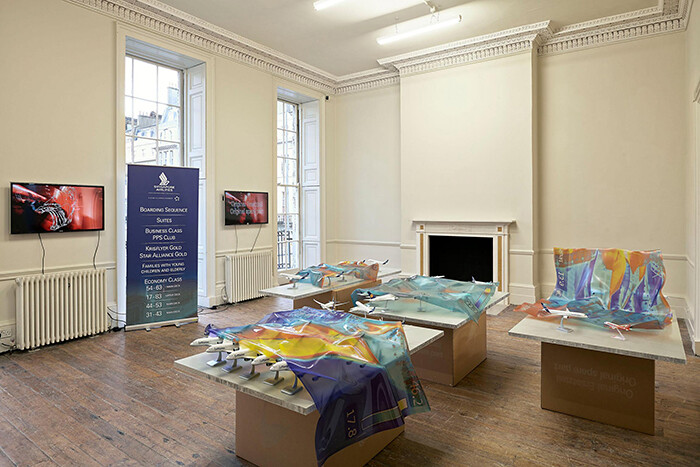On a recent long-haul flight, I caught myself consumed by a scene on the little screen in front of me. In addition to the in-flight entertainment program and the animated map view, the interface offered a live feed from a camera attached to the bottom of the plane, tracking a vista down to Earth surrounded by the night sky. It was a curious deferral of information that—despite communicating live footage of my trip—felt artificial and removed. The images did not seem to match the view from my window and instead offered a glance at a different reality, as if I were looking at another Earth and tracking someone else’s travel, not my own.
The kind of alienation we develop towards our immediate surroundings—driven by radical social and technological changes and their resulting consolidation and internalization—is central to Yngve Holen’s work. The Norwegian artist’s first gallery show with Modern Art, which takes place in their interim space, an eighteenth-century townhouse in London’s Fitzrovia district, continues his investigation of the physical and psychological makeup of commodities and the spaces in which we encounter them—notwithstanding the irony that it is through the objects we create that we comprehend ourselves and our surroundings. Holen is not alone in this interest, but rather aligned with a similar type of artistic production currently coming out of Berlin. Embracing the gallery’s provisional atmosphere, he simulates the look and feel of a transitory showroom by using adaptable display structures and cardboard boxes. Like a traveling salesman or motivational speaker, Holen sets up shop, unpacking his paraphernalia while barely interacting with the space. The works, all titled Original Ersatzteil, Original Spare Part (2014), include their own display structures, which appear to be hastily installed as if they could be immediately dismantled and packed back into their boxes at a moment’s notice.
Customized cardboard boxes, whose imprint lends the exhibition its title, “Original Spare Part,” are positioned throughout the show. Labeled with a glow-in-the-dark, silkscreen logo made of a vector graphic of a cut of beef—an icon that pops up throughout the exhibition—the boxes serve as pedestals for tabletops made of large honeycomb panels, upon which Holen has displayed a variety of model airplanes. Thin Perspex sheets, which he heated before placing on top of the models, have hardened into the shape of the objects beneath them. Glinting in the light like silk shawls, they are covered with images he shot of empty airline cabins with a heat-sensitive camera. Diptychs of the same imagery printed on canvas and layered with technological data also occupy the gallery walls.
A freestanding, roll-up banner positioned between two high-definition flat screens announces the benefits of air travel with Singapore Airlines. The familiar corporate identity promises Business Class travel, Priority Passenger Service (PPS) Club privileges, and access to Singapore Airlines Suites (a luxury class on the company’s Airbus A380 cabins), while the synchronized videos contain footage the artist shot with a camera embedded in a pair of glasses he wore on board an operational flight. Engraved with Holen’s familiar graphic of a cut of beef, the footage is deeply infused with pixelated neon colors characteristic of much recent digital art. The banner, although largely appropriated from actual corporate material, has been updated with a font currently popular in corporate communication, and the heat-sensitive imagery used in other parts of the show blends into its aesthetic, undermining the Singapore Airlines’ signature blue at the bottom of the vinyl.
Model airplanes, once a cherished trophy of the nascent frequent flyer class, are arranged here with neither the attention to detail of the avid model collector, nor the shrewd eye of the strategic salesman. Instead, they seem to be cast aside like long outdated merchandise. Amid the installation, two of the honeycomb tabletops showcase white, hollow, 3D-Selective Laser Sintering prints. One of them depicts an oversized version of a mobile phone and a cut of beef, while the other two are placed on top of Holen’s recent publication ETOPS (2013), a catalog-cum-in-flight magazine largely consistent with promotional aerospace imagery and intermixed with images of in-flight travel taken from various social media websites. The book’s title is an aviation acronym that refers to allowable flight distances for airplanes (it originally stood for “Extended Range Operation with Two-Engine Airplanes,” but has since been simplified to “Extended Operations” in order to address multi-engine aircrafts and polar flights).
The curious combination of meat and aeronautical travel is one of Holen’s ongoing interests. While investigating a collective, cultural longing for air travel and global exchange, he reveals that in order to supply the planet’s ever-growing population, our food is hauled in from far away places. Interestingly, the actual human body proves undetectable in the work; the images taken with the heat-sensitive camera reveal no sign of its bodily heat. Could it be that meat has supplanted the human body? Well, not meat itself, but a 3D-print of it made with help of a CT scan, a technology originally developed to examine the human brain.
When Charles and Ray Eames first illustrated in their iconic film The Powers of Ten (1977) how the zoom away from Earth mimics the zoom inside of the human body, they suggested that technologies of perception can have an immediate impact on our artistic production. Holen’s use of technologies originally invented for the human body on inanimate objects in order to demonstrate their interchangability echoes the Eames’ own revelation on film. However, this collapse of technology is by far the most gripping fact of this exhibition—a show that otherwise appears complicit with corporate aesthetics in which any position on part of the artist is threatened by a rather vacuous ambivalence.









